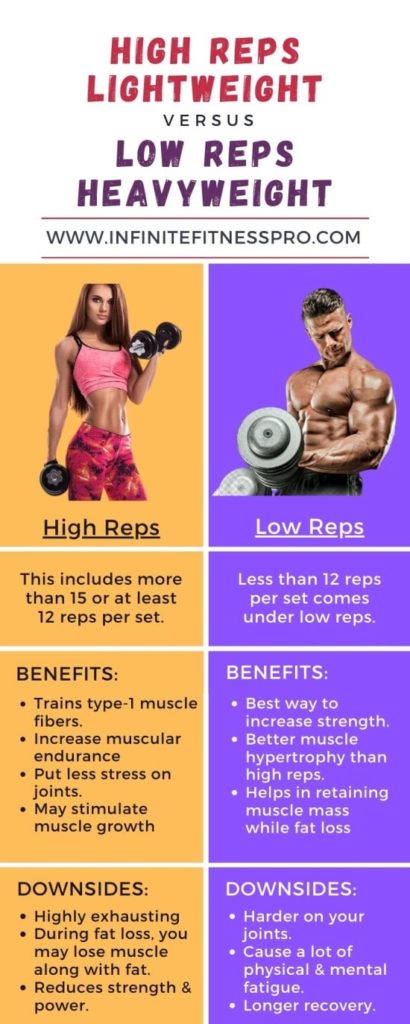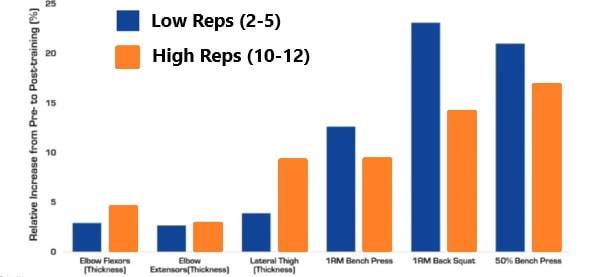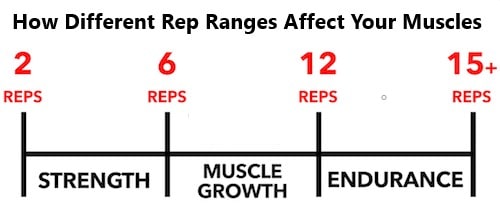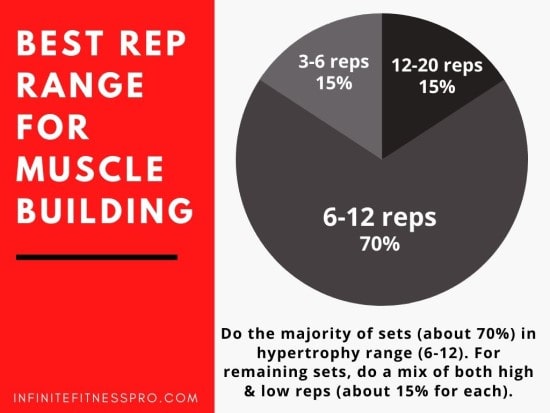High reps vs low reps – Which would be the best training strategy to achieve your physique goals? Many lifters have this confusion that in what rep range should they train – high reps or low reps.
You are lifting weights probably to gain muscle, to lose fat, or to build strength. Whatever your goal is, optimizing your workout with proper rep range is a very important factor to achieve it.
This article will give you a research-based analysis of high reps vs low reps. So let’s dive deep into it.
High Reps Vs Low Reps: Which Rep Range Is Better And Why?
As a trainer, people often ask me this question that which rep range gives the best results. Well, different rep ranges affect you differently. It totally depends on your goal that which one is better for you.
Here are the benefits and downsides of high reps with light weight vs low reps with heavy weight.

Let’s understand on the basis of goals – fat loss, muscle gain, and strength.
High Reps Vs Low Reps – Fat Loss
There is a common misconception that if you want to lose fat then do high reps with lighter weights. People believe that the burn they feel after doing high reps (more than 12 reps) means fat burning.
Well, the burn you feel is just because of the lactic acid produces in your muscles. It does not mean that it burns fat better than low reps with heavy weight.
There is no such study that proves it is better to do high reps with lightweight for fat loss.
Read more: Do High Reps Burn more Fat, or just a myth?
So what should you have done to lose fat?
The fact is that it is not the amount of weight you are lifting or the number of repetitions that helps in burning more fat. It is the intensity of your workout that matters.
The best way to increase intensity is by taking less rests between sets and exercises. This will give you better metabolic and caloric burn effects which ultimately helps in fat loss.
In addition, the major factor during your fat loss journey is a calory restricted diet and proper nutrition. Diet plays a much greater role in fat loss.
Related article: How to Calculate Macros for Cutting Diet
Instead of high reps, lift heavy
Yes, you read that right.
Do 5-10 reps per set with moderate to heavy weights. This works best for fat loss while maintaining the muscles you already have.
Lifting heavy weights for fewer repetitions would be a better workout strategy during fat loss. It doesn’t burn more fat but it definitely helps you in retaining your muscle mass.
A study from the University of Alabama shows that “people who did high reps or just cardio lost the same amount of weight as people who lift heavy weights, but almost all the weight lost by heavy lifters was fat whereas the other group lost muscle along with fat.“
High Reps Vs Low Reps – Muscle Gain
The optimal number of rep range in order to maximize muscle hypertrophy is still open to debate as there is no conclusive study.
Most studies show that rep range less than 15 is better to gain muscle, but other studies show high reps with lightweight are equally effective to build muscle.
Most people believe that the heavier the weight you lift, the more the muscle you gain. Well, it is not that simple. There are various factors involve.
Let me explain how different rep ranges affect your muscle-building process…
Low reps (less than 6) with heavy weights…
- It focuses on building strength and power.
- More pressure on joints
- CNS fatigue
- Need more time to recover
Keep lifting super heavyweights for a long time puts a lot of pressure on your body and mind.
It stresses your joints and fatigues your CNS (central nervous system) throughout the week. Due to which your body may not recover properly which can cause an adverse effect on your muscle-building process.
High reps (more than 12) with light weight…
- Endurance training
- Not much effective for gaining muscle size.
- Good for your joint health
- Takes less time to recover
When you do high reps with lightweight, then you are training your muscles for endurance. That means, doing the same movement for a longer time.
This is a good way to train your slow-twitch muscle fibers but it doesn’t incorporate your fast-twitch muscle fibers, which are majorly responsible for gaining muscle size.
So what would be the best rep range for muscle building?
The best way is putting most of your workout in a hypertrophy range i.e, 6-12 reps to build muscle mass. However, it would be better to incorporate other rep ranges for more benefits.
For example, you can do 1-2 sets of a compound exercise (like bench press or deadlift) for low reps with ultra heavy weights. Then do most of your sets in hypertrophy rep range. In the end, do some finishing sets for 12+ reps.
In this way, you will get the benefits of all the rep ranges without hampering your gains and much CNS fatigue.
High Reps Vs Low Reps – Strength
For improving strength, it is always advisable to lift heavy weights for a lower rep range (less than 6).
The graph below clearly shows that low rep range works best to increase 1-RM.

However, lifting lighter weights for high reps may also contribute to improving strength, but most of the researches support heavy load training for strength gain.
A study was done at Victoria University, Melbourne, Australia shows that “maximum strength benefits are obtained by lifting heavy loads for fewer reps.”
High Reps Vs Low Reps: Benefits & Downsides
Whatever your goal is, all the rep ranges have their own benefits and downsides.
Benefits of high reps:
- Do more focus on type-1 (slow-twitch) muscle fibers.
- Increases endurance capability of your muscles.
- Put less stress on your joints.
- May stimulate muscle growth due to added metabolic stress.
Downsides of high reps:
- Many people found it extremely exhausting, especially during compound exercises like deadlifts and squats.
- During fat loss, there are more chances of losing muscles along with fat.
- Not optimal for gaining strength and power.
Benefits of low reps:
- Best way to increase strength.
- More beneficial for muscle building as compared to high reps.
- It helps in retaining maximum muscle mass during fat loss.
Downsides of low reps:
- Harder on your joints.
- Cause a significant amount of physical and mental fatigue.
- It makes hard for your body to recover.
Conclusion: The Best Rep Range To Build Muscle

If you are still confused in deciding the best rep range for you, then here is what I’d recommend.
As the ultimate goal of most of the gym freaks is to build muscle, so this would be the best strategy to do that:
- Do the majority of your sets (about 70%) in the hypertrophy range i.e, 6-12 reps.
- For remaining sets, do a mix of both high reps and low reps with lightweight and heavyweight (about 15% for each).
In this way, you are able to reap all the benefits that different rep ranges offer.

How To Incorporate This In Your Routine?
Here I have given some examples to show how you can achieve this:
Example of a chest workout
- Barbell bench press: 4 sets of 4-6 reps
- Incline dumbbell press: 4 sets of 6-12 reps
- Flat flies: 3 sets of 8-12 reps
- Cable flies: 3 sets of 12-15 reps
Another example of a back workout
- Pullups: 3-4 sets of 10 reps each
- Barbell bent-over rows: 4 sets of 6-12 reps
- Deadlift: 4 sets of 4-8 reps
- T-bar rows: 3 sets of 10-15 reps
If you are on an upper/lower or push/pull/leg split
- Upper 1: Low reps (less than 8)
- Lower 1: Low reps (less than 8)
- Upper 2: High reps (up to 15)
- Lower 2: High reps (up to 15)
Another way is by doing periodization. In this technique, you keep training in a particular rep range for some days and then go on a different rep range.
For example:
- 1st month: Heavyweight, low reps (Strength)
- 2nd month: Moderate weight, medium rep range (Hypertrophy)
- 3rd month: Light weight, high reps (Endurance)
These were some of the examples of incorporating different rep ranges in your workout. But the best way is to experiment with it and find out which strategy your body responds the best.
Do whatever you feel good but make sure to not sticking with a specific rep range. Incorporate all of them to get the maximum benefits.
FAQs
Researches conclude that lifting heavy weight for low reps or hypertrophy rep range i.e, 6-12 reps are the best to build muscle. While high reps training is good for muscular endurance.
No, this is just a myth. High reps with lightweight train your slow-twitch (type-1) muscle fibers and increases muscular endurance. To build definition you have to reduce your body fat percentage.
The muscles which contain mostly slow-twitch muscle fibers tend to show better growth with high rep training. For example calves, rear deltoids, and forearm muscles.
High reps with lightweight do not give you any better fat-burning benefits. Instead, lift heavy (to retain muscle mass), add some cardio in your routine, and take a caloric deficit diet to lose fat.
Thanks for reading this far. I hope this article was helpful to you. If you still have any queries regarding this, just leave a comment down below.





One Comment on “High Reps vs Low Reps: Which Is Better?”
Comments are closed.